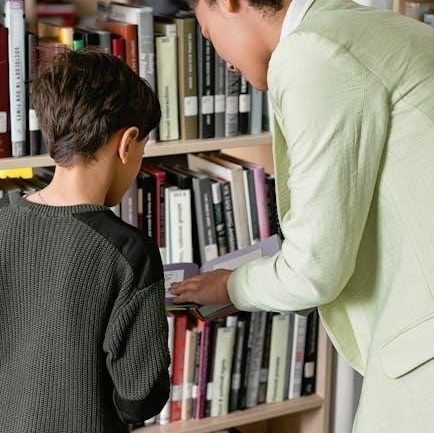The Kindergarten Curriculum Guide is designed to provide a comprehensive framework for early childhood education, focusing on foundational skills and child-centered learning. It outlines objectives, strategies, and expectations for holistic development, ensuring collaboration between teachers and parents for a nurturing environment.
1.1 Overview of the Importance of Kindergarten Education
Kindergarten education serves as the foundation for lifelong learning, fostering social, emotional, and cognitive development in young children. It provides a nurturing environment where children explore, create, and learn essential skills. This stage builds curiosity, creativity, and a love for learning, preparing children for future academic success. Kindergarten also helps develop critical social skills, such as cooperation and communication, while introducing foundational concepts in literacy, numeracy, and problem-solving. By focusing on child-centered activities, kindergarten empowers children to grow into confident, independent learners, ready to thrive in an ever-evolving world.
1.2 Objectives of the Kindergarten Curriculum
The Kindergarten curriculum is designed to achieve specific developmental goals, ensuring children develop holistically. It aims to enhance literacy and numeracy skills, foster creativity, and promote social-emotional growth. The curriculum encourages curiosity, critical thinking, and problem-solving abilities, preparing children for future challenges. It emphasizes the development of moral values, cultural awareness, and physical well-being. By providing a child-centered approach, the curriculum ensures that each child progresses at their own pace, building confidence and a strong foundation for lifelong learning. These objectives are tailored to meet the diverse needs of children, fostering a love for learning and readiness for subsequent educational stages.
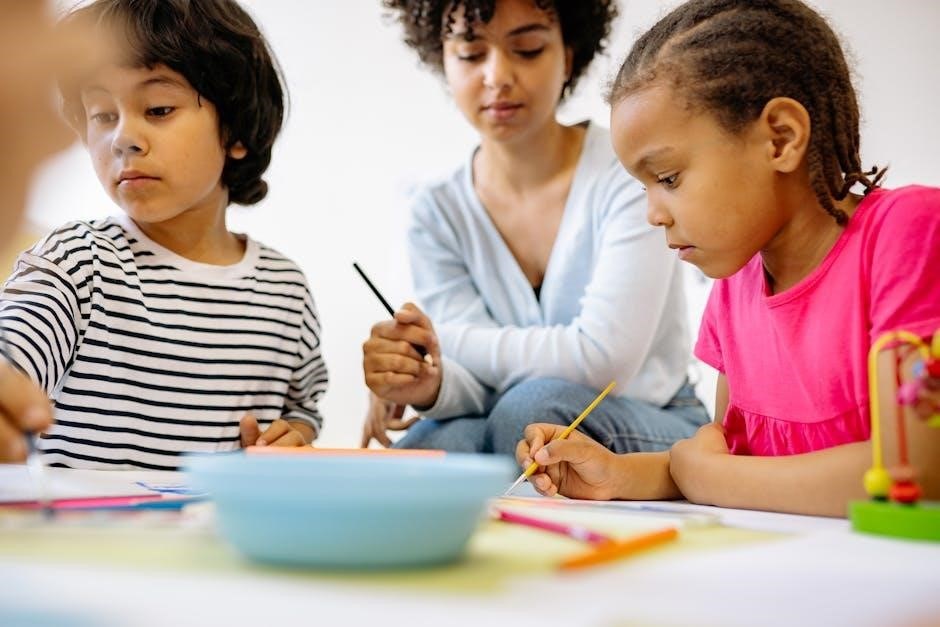
Core Components of the Kindergarten Curriculum
The Kindergarten curriculum focuses on foundational literacy, numeracy, science, and social studies, while integrating art, music, and physical education to promote holistic child development and engagement.
2.1 Foundational Skills for Reading and Literacy
The kindergarten curriculum emphasizes foundational reading and literacy skills, including alphabet recognition, phonemic awareness, and sight word identification. It introduces basic comprehension strategies, fostering a love for reading through interactive stories and hands-on activities. Teachers use engaging methods to help children decode words, understand sentence structures, and develop vocabulary. Literacy skills are integrated across all subjects, encouraging children to apply their knowledge in meaningful contexts. The curriculum also supports early writing skills, such as tracing, labeling, and creative expression. By the end of kindergarten, students are expected to demonstrate proficiency in recognizing letters, blending sounds, and retelling simple stories, setting the stage for future academic success.
2.2 Mathematics and Numeracy Development
The kindergarten curriculum focuses on developing essential math and numeracy skills through hands-on activities and play-based learning. Key areas include counting, basic addition and subtraction, shape recognition, and understanding quantities. Children learn to identify numbers, sequence events, and compare sizes and quantities. The curriculum incorporates manipulatives, such as blocks and counters, to enhance problem-solving abilities. Real-world applications, like measuring and sorting, help children connect math to daily life. Technology tools, such as educational apps, are also used to engage learners. By the end of kindergarten, students demonstrate an understanding of foundational math concepts, preparing them for more complex skills in higher grades.
2.3 Science and Social Studies Integration
The kindergarten curriculum integrates science and social studies to foster curiosity and understanding of the world. Activities focus on exploration, observation, and hands-on learning, encouraging children to ask questions and seek answers. Science topics include basic concepts like seasons, plants, and animals, while social studies introduce family, community, and cultural awareness. Interactive lessons, such as sorting objects or discussing traditions, help children develop critical thinking and interpersonal skills. The integration of these subjects promotes a holistic learning experience, preparing students to appreciate their role in society and the natural world while building a strong foundation for future academic success.
2.4 Art, Music, and Physical Education
The kindergarten curriculum places a strong emphasis on art, music, and physical education to foster creativity, self-expression, and physical well-being. Art activities encourage children to explore colors, textures, and shapes through painting, drawing, and crafts, nurturing their imagination and fine motor skills. Music introduces rhythm, melody, and movement, helping children develop auditory skills and creativity. Physical education focuses on gross motor development through play, games, and exercises, promoting coordination, balance, and teamwork. These subjects are integrated to create a balanced learning experience, ensuring children grow holistically while developing essential life skills in a fun and engaging manner.
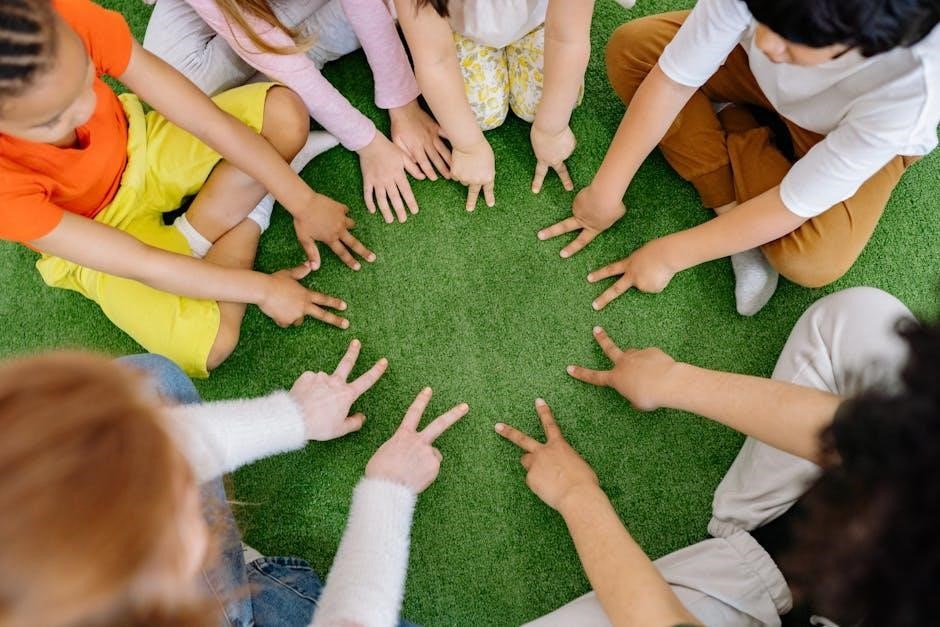
Subject-Specific Curriculum Details
This section provides a comprehensive overview of the kindergarten curriculum, detailing learning objectives and activities for English, math, science, social studies, art, music, and physical education.
3.1 English Language and Literacy
The English Language and Literacy curriculum focuses on developing foundational reading and writing skills. It introduces the alphabet, sight words, and basic phonics to build reading readiness. Activities include storytelling, rhyming games, and interactive exercises to foster a love for language. Writing skills are nurtured through tracing, drawing, and simple sentence construction. Speaking and listening skills are enhanced through group discussions and role-playing. The curriculum emphasizes a nurturing environment where children explore language creatively, supported by teachers and parents to ensure a strong literacy foundation for future academic success.
3.2 Mathematics and Problem-Solving Skills
The Mathematics and Problem-Solving Skills section of the kindergarten curriculum focuses on developing foundational numerical understanding and critical thinking. It introduces concepts such as number recognition, counting, and basic addition and subtraction. Activities include play-based learning with manipulatives, shape sorting, and pattern recognition to foster logical thinking. Problem-solving is encouraged through real-world applications, like measuring objects and solving simple puzzles. The curriculum emphasizes a hands-on approach to math, enabling children to explore concepts at their own pace. This builds a strong foundation for future math skills and nurtures curiosity and confidence in tackling challenges.
3.3 Science Exploration and Discovery
The Science Exploration and Discovery section encourages young learners to engage with the natural world through hands-on activities and curiosity-driven experiences. It introduces basic scientific concepts like seasons, plants, and animals, while fostering observation and classification skills. Children participate in simple experiments and nature walks to explore their environment. This section emphasizes the development of critical thinking through questioning and predicting outcomes. Interactive tools and materials, such as magnifying glasses and sorting games, are used to make learning engaging. The curriculum aims to build a foundation for scientific literacy and inspire a lifelong love for discovery and learning in kindergarten students.
3.4 Social Studies and Cultural Awareness
The Social Studies and Cultural Awareness component introduces young learners to their community, family, and cultural heritage. It focuses on developing an understanding of basic social structures, traditions, and diverse cultures. Activities include stories, discussions, and role-playing to explore community helpers, holidays, and cultural practices. Students learn to appreciate differences and similarities among people, fostering empathy and respect. The curriculum also incorporates geography through simple maps and discussions about their immediate environment. This section aims to build a sense of belonging and prepare children for global citizenship by introducing them to the richness of cultural diversity in an age-appropriate manner.
3.5 Art and Creative Expression
Art and Creative Expression in the kindergarten curriculum encourages children to explore their imagination through various mediums like drawing, painting, and crafts. This section focuses on developing fine motor skills, creativity, and self-expression. Students learn to use art tools safely and experiment with colors, textures, and shapes. Activities are designed to foster confidence and individuality, allowing children to communicate their thoughts and feelings visually. The curriculum also integrates cultural elements, introducing students to different art styles and traditions. By emphasizing the process over the product, the goal is to nurture a lifelong appreciation for artistic expression and creativity in young learners. This fosters innovation and joy in learning.
3.6 Music and Movement
Music and Movement in the kindergarten curriculum are vital for nurturing creativity and physical development. Activities such as singing songs, recognizing rhythms, and engaging in creative dances enhance motor skills and coordination. Students also learn to play simple instruments, fostering an appreciation for music. Movement games introduce basic sports skills and promote teamwork. These integrated activities contribute to social and emotional growth while laying the foundation for lifelong physical activity and musical enjoyment. The curriculum ensures learning is both enjoyable and engaging, effectively preparing children for future academic and personal development.
3.7 Physical Education and Health
Physical Education and Health in kindergarten focus on developing motor skills, coordination, and an understanding of wellness. Activities include age-appropriate games, balance exercises, and team-building tasks to enhance physical fitness. Health lessons introduce basic concepts like hygiene, nutrition, and safety. The curriculum encourages active play to promote overall well-being and lifelong healthy habits. These lessons are designed to foster independence, self-awareness, and a positive attitude toward physical activity. By integrating movement and health education, the program ensures a holistic approach to child development, preparing students for a healthy and active lifestyle.

Skills Development in Kindergarten
Kindergarten skills development focuses on building social-emotional intelligence, cognitive growth, and physical dexterity through play-based learning and interactive activities, fostering creativity and problem-solving abilities in young learners.
4.1 Social-Emotional Learning (SEL)
Social-Emotional Learning (SEL) in kindergarten focuses on developing self-awareness, self-regulation, and social skills. It encourages children to recognize emotions, express empathy, and build positive relationships. Through play-based activities and group interactions, students learn to cooperate, share, and resolve conflicts. SEL is integrated into daily routines, helping children develop resilience and confidence. Teachers guide students in understanding their emotions and developing strategies to manage stress. This foundation supports academic success and fosters a sense of community. By nurturing these skills, kindergarten programs prepare children for lifelong social and emotional well-being, enabling them to thrive in diverse environments and relationships.
4.2 Cognitive and Language Development
Cognitive and language development in kindergarten focuses on enhancing problem-solving skills, memory, and communication abilities. Activities like storytelling, alphabet recognition, and simple math games stimulate thinking and logical reasoning. Language development is fostered through reading aloud, vocabulary building, and conversational practice. Teachers encourage children to express thoughts clearly and listen actively. Interactive games and hands-on experiments further promote critical thinking and curiosity. This foundation prepares students for more complex learning in future grades, ensuring they can articulate ideas effectively and engage confidently in academic and social interactions. The curriculum emphasizes making learning engaging and accessible for all learners.
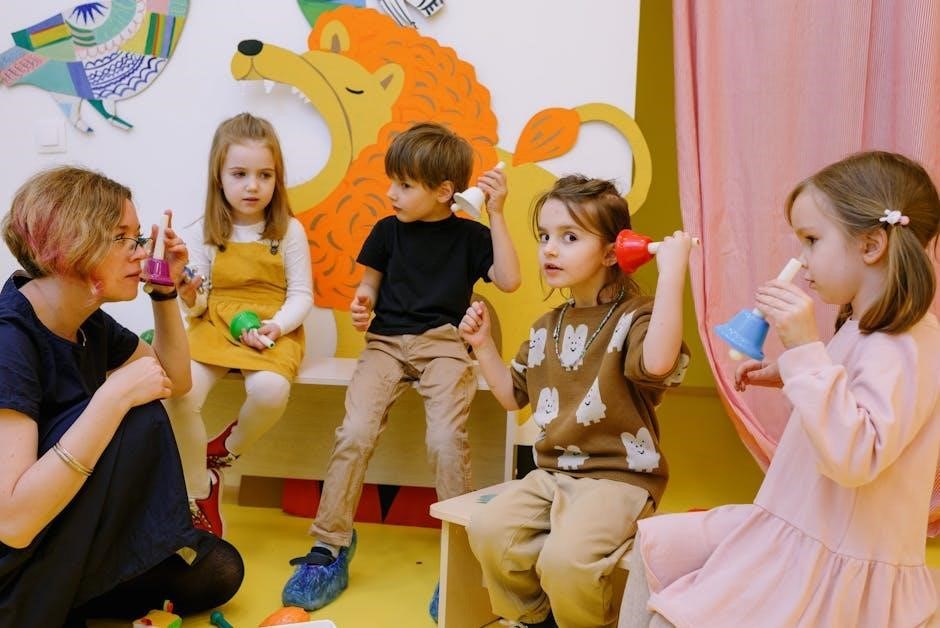
4.3 Fine and Gross Motor Skills
Fine and gross motor skills are essential for kindergarten development, enhancing coordination, balance, and dexterity. Activities like drawing, puzzles, and using scissors improve fine motor abilities, while play-based exercises such as running, jumping, and throwing develop gross motor skills. These activities foster physical confidence and readiness for academic tasks. Teachers incorporate play-based learning to encourage practice and mastery. The curriculum emphasizes the importance of movement and creativity in building foundational skills. By engaging in hands-on experiences, children refine their abilities, preparing them for more complex tasks in later grades. Motor skill development is integrated seamlessly into daily routines, ensuring a holistic approach to learning.
4.4 Critical Thinking and Creativity
Critical thinking and creativity are nurtured through engaging activities that encourage exploration and innovation. Kindergartners participate in open-ended projects, such as building with blocks or creating art, to foster imaginative problem-solving. Role-playing and storytelling activities enhance creativity while developing language skills. Teachers use questioning techniques to prompt deeper thinking, helping children analyze situations and make informed decisions. These experiences build a foundation for independent thought and innovation, preparing children to approach challenges with confidence and originality. By integrating creative expression into learning, the curriculum ensures children develop essential skills for lifelong learning and adaptability in a changing world.
4.5 Technology Integration
Technology integration in kindergarten introduces young learners to digital tools that enhance their educational experience. Interactive apps, educational games, and multimedia resources are used to support foundational skills in areas like math and literacy. These tools are designed to be engaging and age-appropriate, fostering problem-solving abilities and creativity. Additionally, technology helps develop hand-eye coordination and fine motor skills through touchscreen activities. Teachers guide students to use technology responsibly, ensuring a balance between screen time and traditional play-based learning. This approach prepares children for a technology-driven world while maintaining a focus on overall development.
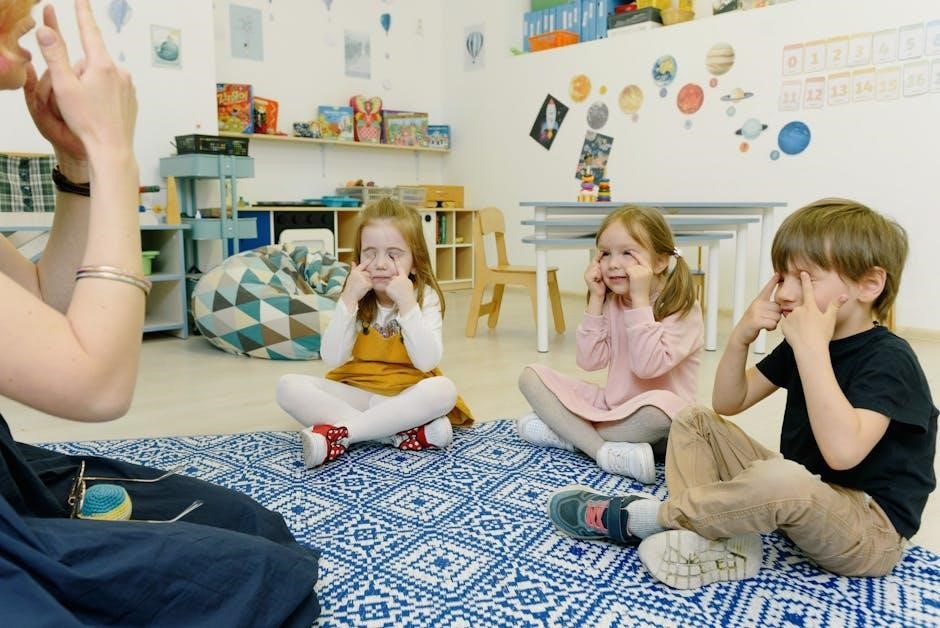
Assessment and Evaluation in Kindergarten
Assessment and evaluation in kindergarten involve observing student progress, using tools to measure development, and reporting growth to parents, ensuring personalized learning and effective support.
5.1 Methods of Assessing Student Progress
Assessment in kindergarten often involves observational methods, portfolios, and developmental checklists to monitor progress. Teachers use performance tasks and informal evaluations to gauge readiness and understanding. Standardized tests are limited, focusing instead on play-based and project-oriented assessments to capture natural learning behaviors. Progress is documented through work samples, peer interactions, and self-expression activities, ensuring a holistic view of each child’s development. These methods align with the curriculum’s emphasis on child-centered learning, allowing for personalized feedback and tailored instruction to meet individual needs effectively while fostering a supportive and engaging educational environment.
5.2 Tools and Resources for Evaluation
Evaluation in kindergarten utilizes a variety of tools and resources to track student progress effectively. Developmental checklists, observation forms, and portfolio assessments are commonly employed to document growth. Digital platforms and learning management systems provide structured frameworks for recording and analyzing data. Standardized tests, when appropriate, are adapted to age-specific needs. Additionally, teacher-created assessments, such as quizzes and activity-based evaluations, help measure mastery of skills. These tools enable educators to identify strengths, address gaps, and provide targeted support, ensuring a comprehensive understanding of each child’s developmental journey while maintaining alignment with curriculum goals and developmental milestones.
5.3 Reporting Student Development
Reporting student development in kindergarten involves sharing progress with parents through structured formats. Teachers use progress reports, parent-teacher conferences, and digital portfolios to communicate milestones. These reports highlight achievements in literacy, numeracy, social skills, and emotional growth. Parents receive actionable insights to support their child’s learning journey. Additionally, schools may utilize online platforms for real-time updates, ensuring transparency and continuous engagement. Reports are tailored to individual needs, celebrating strengths and identifying areas for further development. This collaborative approach fosters a partnership between educators and families, aligning home and school efforts to promote holistic child development and prepare students for future academic success.
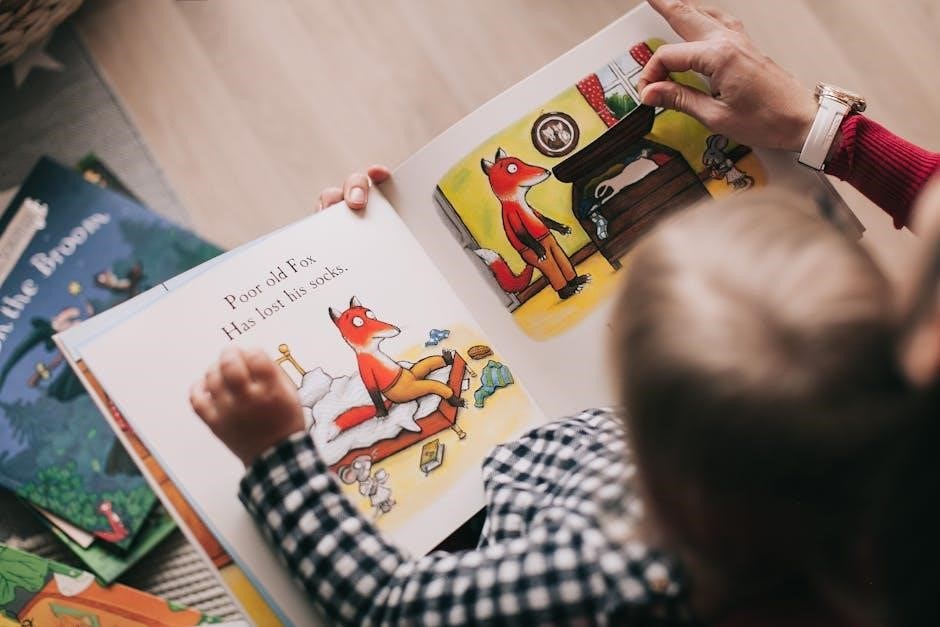
The Role of Teachers in Curriculum Implementation
Teachers play a vital role in planning and delivering the kindergarten curriculum, ensuring engaging lessons and activities that cater to diverse learning needs and styles daily.
6.1 Responsibilities of Kindergarten Teachers
Kindergarten teachers are responsible for planning and implementing daily lessons, ensuring alignment with curriculum goals. They create engaging activities, assess student progress, and adapt instruction to meet individual needs. Teachers foster a supportive learning environment, promoting social-emotional development and collaboration among students. They also communicate regularly with parents, providing updates on their child’s growth and involving them in educational processes. Additionally, teachers manage classroom materials, maintain organization, and ensure safety. Their role extends to identifying learning challenges and collaborating with specialists to support students. Effective teachers are flexible, innovative, and committed to nurturing the whole child, laying a strong foundation for future academic success.
6.2 Strategies for Effective Teaching
Effective teaching in kindergarten involves creating engaging, interactive, and child-centered lessons. Teachers use play-based learning to foster curiosity and hands-on exploration. They incorporate project-based activities that integrate multiple subjects, promoting deeper understanding. Differentiated instruction tailors learning to individual needs, ensuring all students thrive. Technology integration, such as educational apps and digital tools, enhances learning experiences. Teachers also encourage collaborative group work to build social skills and teamwork. Incorporating music, art, and movement makes learning fun and memorable. Regular formative assessments help track progress and adjust teaching strategies. By maintaining a nurturing and inclusive classroom environment, teachers inspire a love for learning and set the foundation for future academic success.
6.3 Professional Development for Teachers
Professional development for kindergarten teachers is essential to enhance their skills and knowledge in delivering effective instruction. Workshops, conferences, and online courses provide teachers with updated strategies and tools to create engaging lessons. Collaborative opportunities with fellow educators and experts foster shared learning and innovative practices. Technology integration training equips teachers to use digital tools effectively in the classroom. Continuous professional growth ensures teachers stay aligned with curriculum standards and best practices. By investing in teacher development, schools can improve the quality of education and better support young learners’ developmental needs, ultimately fostering a more effective and inspiring learning environment for all students.
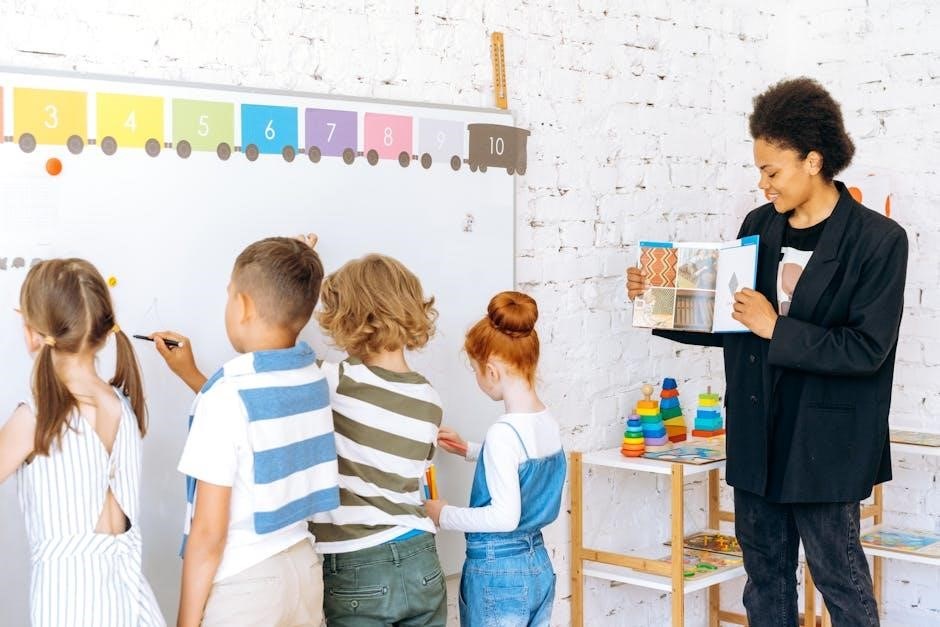
Parental Involvement in Kindergarten Education
Parental involvement is crucial for a child’s development, fostering collaboration between home and school. It enhances learning, builds trust, and creates a supportive environment for young learners.
7.1 Ways Parents Can Support Learning
Parents play a vital role in supporting their child’s learning by creating a nurturing environment at home. They can engage in regular communication with teachers, attend school meetings, and participate in parent-teacher associations. Encouraging daily reading, practicing alphabet and number recognition, and discussing the child’s day fosters academic growth. Providing resources like educational toys and materials also enhances learning. Parents should maintain open dialogue with teachers to stay informed about their child’s progress and any additional support needed. By reinforcing classroom lessons and promoting curiosity, parents can help their child develop a strong foundation for future success. Active involvement ensures holistic development.
7.2 Communication Between Parents and Teachers
Effective communication between parents and teachers is essential for a child’s educational success. Regular updates through meetings, emails, or newsletters ensure parents are informed about their child’s progress. Teachers can share insights into classroom activities, while parents can provide feedback on their child’s development. Open dialogue helps align teaching methods with home practices, creating a consistent learning environment. Active listening and mutual respect foster trust, enabling collaborative decision-making. Tools like parent-teacher apps or progress reports further facilitate seamless communication. By maintaining regular and meaningful interactions, parents and teachers can work together to support the child’s academic and personal growth effectively.
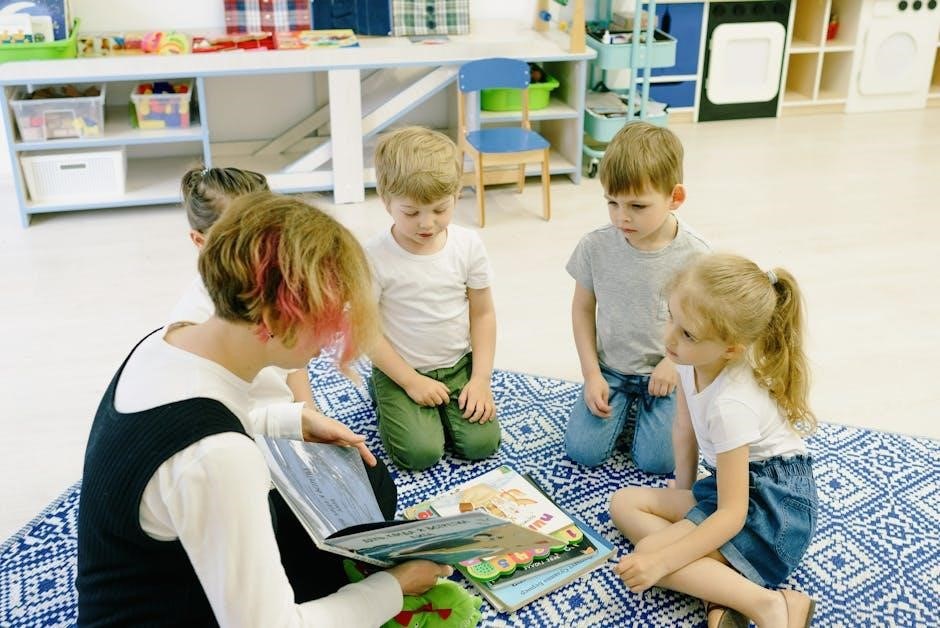
7.3 Parent-Teacher Collaboration
Parent-teacher collaboration is a vital partnership that enhances a child’s educational journey. By working together, parents and teachers can align goals, share strategies, and create a supportive learning environment. Parents can volunteer in classrooms, participate in school events, or contribute to lesson planning. Teachers can involve parents in decision-making processes, such as selecting educational materials or organizing activities. Regular collaboration fosters a sense of community and ensures consistency in teaching methods. When parents and teachers collaborate, they demonstrate teamwork and commitment, which inspires children to take an active role in their own learning. This shared responsibility enriches the child’s development and success.
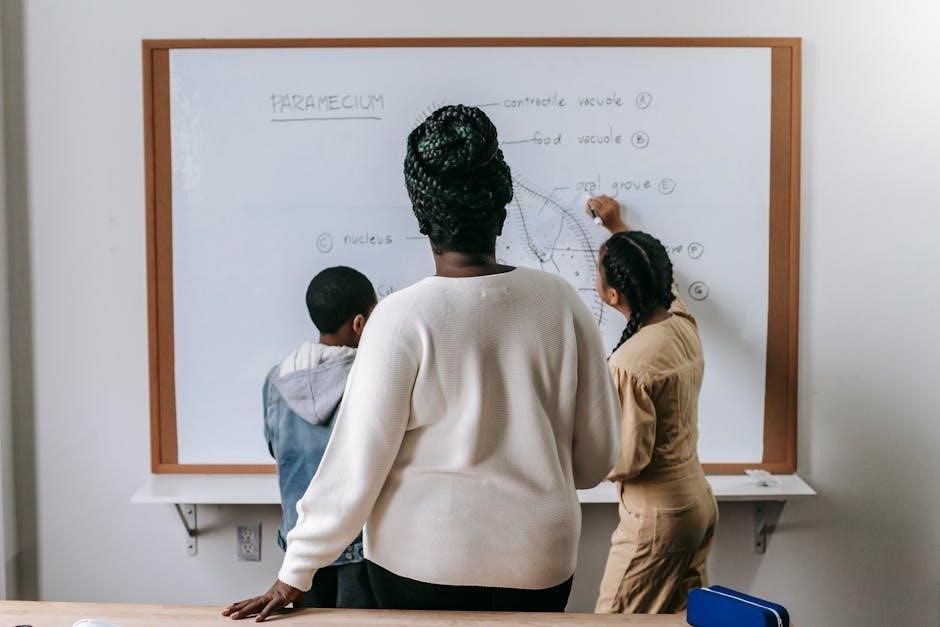
Future Trends in Kindergarten Curriculum Design
Future trends emphasize integrating emerging technologies, global perspectives, and play-based learning to foster creativity and critical thinking in young learners, preparing them for future challenges.
8.1 Emerging Technologies in Kindergarten Classrooms
Emerging technologies are transforming kindergarten classrooms, enhancing engagement and accessibility. Interactive whiteboards, educational apps, and tablets enable hands-on learning, while QR codes link to digital resources. These tools support foundational skills development, such as reading and math, through interactive and personalized experiences. They also foster creativity and collaboration, preparing young learners for a tech-driven future. By integrating technology thoughtfully, educators create dynamic learning environments that cater to diverse needs and abilities, ensuring kindergartners build essential skills while staying curious and motivated. This approach aligns with modern educational goals, promoting innovation and readiness for lifelong learning in an increasingly digital world.
8.2 Global Perspectives in Early Childhood Education
Global perspectives in early childhood education emphasize cross-cultural understanding and diversity, preparing children to thrive in an interconnected world. Kindergarten curriculum guides now incorporate international themes, such as global festivals, traditions, and environmental issues, fostering empathy and cultural awareness. Collaborative projects with schools worldwide and bilingual learning opportunities further enrich this approach. By integrating global perspectives, educators help children develop open-mindedness and respect for differences, while addressing global challenges like sustainability. This shift ensures kindergartners grow into informed, compassionate, and globally conscious individuals, ready to contribute positively to society. Such initiatives align with modern educational aims, promoting inclusivity and broadened worldviews from an early age.
8.3 The Role of Play-Based Learning
Play-based learning is a cornerstone of modern kindergarten curriculum design, fostering creativity, curiosity, and natural development. It encourages children to explore, experiment, and learn through interactive activities, making education engaging and enjoyable. Play is not merely recreational; it is a structured approach that enhances social, emotional, and cognitive growth. By integrating play, teachers create opportunities for collaboration, problem-solving, and skill-building in a child-centered environment. This method aligns with global educational trends, emphasizing holistic development and preparing children for future challenges. Play-based learning is now widely recognized as an effective strategy to nurture young learners, ensuring they thrive academically and personally.
